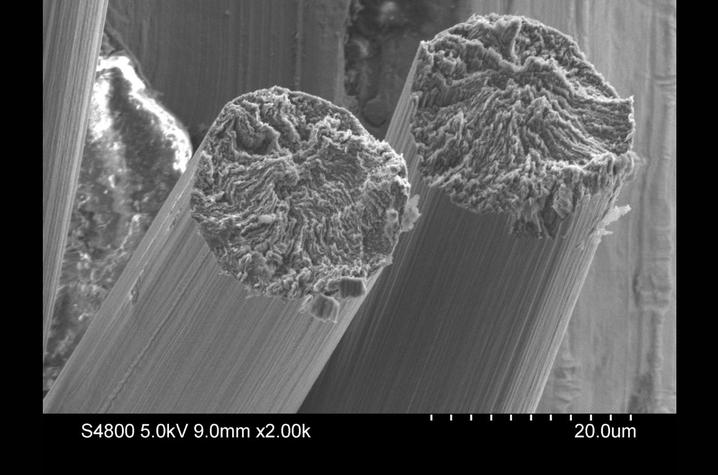UK CAER’s coal-to-carbon fiber research published in Carbon

LEXINGTON, Ky. (Nov. 22, 2023) — At the University of Kentucky’s Center for Applied Energy Research (CAER), scientists’ innovative research to turn Kentucky waste coal into high-value carbon products has been published in the journal Carbon.
The publication titled “Isotropic pitch-derived carbon fiber from waste coal” is the work of CAER’s Carbon Materials Research Group. Authors include John Craddock, George Frank, Michela Martinelli, Justin Lacy, Vivian Edwards, Asmund Vego, Christina Thompson, Rodney Andrews and Matthew Weisenberger.
“We believe this is the first time that carbon fiber has been produced from a recovered waste coal,” said Craddock, lead author of the paper. “This technology could be useful for both low-cost carbon fibers and potential remediation of waste coal impoundments.”
CAER’s carbon materials researchers have become global leaders in turning an environmental liability — impounded waste coal — into a highly sought-after strategic material that is critical to the nation’s transportation, national security and renewable energy sectors.
The technology employed at CAER shows great promise for building a cost-competitive, domestic supply chain for carbon fiber and graphite, strategic materials that are increasingly important to our global economy.
“Coal utilization as an alternative low-cost precursor for carbon products including graphite and carbon fiber has garnered renewed interest,” the authors state in the paper. “Yet little attention has been given to waste coal as a resource.”
Before burning mined coal for power generation, it undergoes washing at preparation plants to remove noncombustible materials. The authors explain this process results in a slurry called underflow, consisting mainly of fine coal, small rock and clay particles suspended in water. Underflow is typically pumped to an impoundment, an embankment constructed for permanent disposal of mining by-product materials.
“It is estimated that about 58 gigatons of this waste coal have been deposited in impoundments around the world,” the authors wrote. “Coal, being a high-carbon material, has garnered attention as a low-cost precursor material for processes and products which capitalize on its inherent aromatic carbon composition.”
This project and breakthrough demonstrate an important utility for an otherwise problematic environmental waste.
This CAER research was supported by the U.S. Department of Energy (DOE) Fossil Energy and Carbon Management Office in collaboration with Oak Ridge National Laboratory.
The project “C4WARD: Coal Conversion for Carbon Fibers and Composites” focuses on developing the fundamental and translational science and engineering necessary to create energy-efficient and cost-effective processes for manufacturing carbon fibers and graphite from coal with tunable properties.
This material is based upon work supported by the U.S. Department of Energy under Award Number DE-AC05-00OR22725. The Oak Ridge National Laboratory is supported by the Office of Science of the U.S. Department of Energy. The Office of Science is the single largest supporter of basic research in the physical sciences in the United States and is working to address some of the most pressing challenges of our time. For more information, please visit science.energy.gov.
As the state’s flagship, land-grant institution, the University of Kentucky exists to advance the Commonwealth. We do that by preparing the next generation of leaders — placing students at the heart of everything we do — and transforming the lives of Kentuckians through education, research and creative work, service and health care. We pride ourselves on being a catalyst for breakthroughs and a force for healing, a place where ingenuity unfolds. It's all made possible by our people — visionaries, disruptors and pioneers — who make up 200 academic programs, a $476.5 million research and development enterprise and a world-class medical center, all on one campus.




